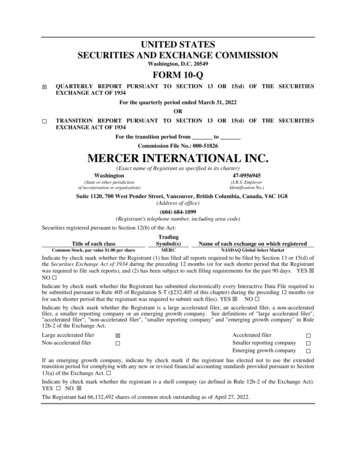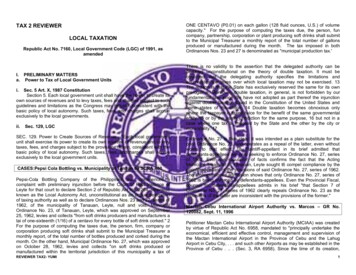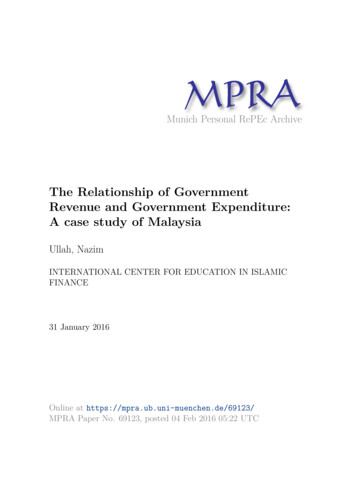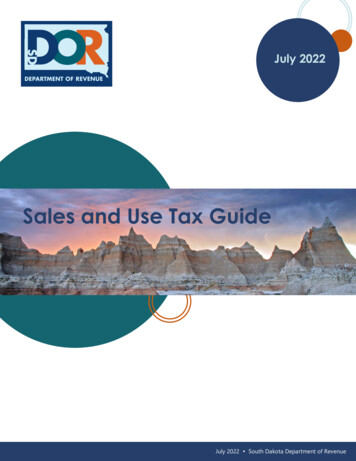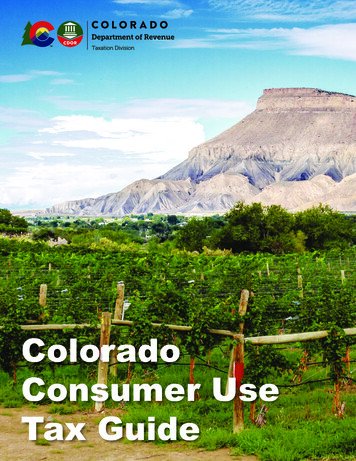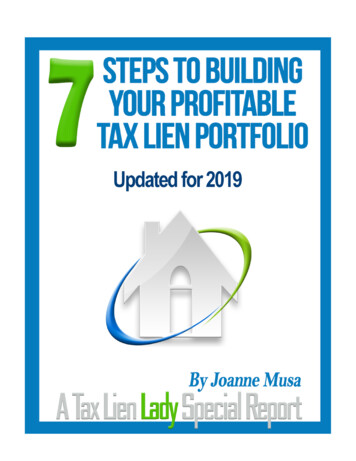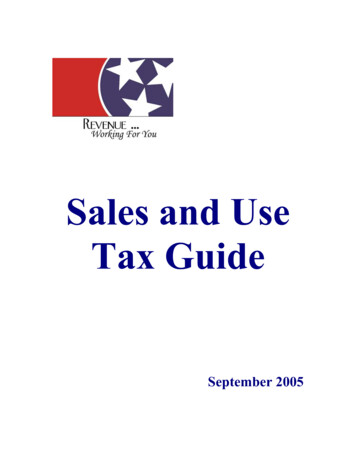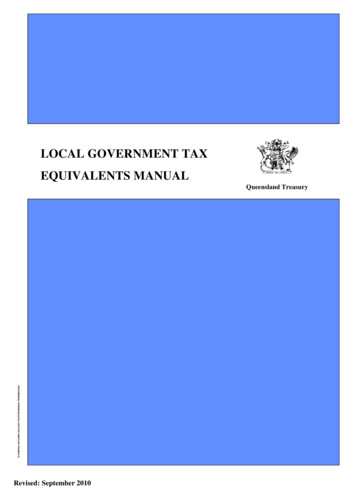
Transcription
LOCAL GOVERNMENT TAXEQUIVALENTS TER98MAN.DOCQueensland TreasuryRevised: September 2010
Local Government Tax Equivalents Manual: Table of Contents(i)TABLE OF CONTENTSTABLE OF CONTENTS . IINTRODUCTION . 1GLOSSARY OF COMMON TERMS . 2OVERVIEW OF THE LOCAL GOVERNMENT TAX EQUIVALENTS REGIME . 4(A) TAX EQUIVALENT MODELS. 5(1) INCOME T AX EQUIVALENTS REGIME. 6Government Imposed Restructures & Transfers .8(2) STATE T AX EQUIVALENTS REGIME . 8(B) ROLE OF THE TAX ASSESSOR . 12(C) ROLE OF THE OFFICE OF STATE REVENUE (OSR) . 15(D) OUTLINE OF THE ADMINISTRATIVE ASPECTS OF LOCAL GOVERNMENTS TAXEQUIVALENTS REGIME. 15INCOME TAX EQUIVALENTS REGIME . 24DIVISION 1 - TAXATION UNDER THE ACCOUNTING PROFITS MODEL. 24DIVISION 2 - TAXATION UNDER THE SUBSTANTIVE ITAA MODEL. 32SCHEDULE 1 . 40RECONCILIATION OF OPERATING PROFIT AND TAXABLE INCOME. 40SCHEDULE 2 . 42PAYG INSTALMENT ACTIVITY STATEMENT (IAS). 42SCHEDULE 3 . 432010 TRANSITIONAL PAYG INSTALMENT ARRANGEMENTS . 43STATE TAX EQUIVALENTS REGIME. 44DIVISION 4 - TAXATION UNDER THE STATE TAX EQUIVALENTS REGIME . 45(A)DUTY . 48(B)PAYROLL TAX. 50(C)LAND TAX. 51INDEX OF THE LOCAL GOVERNMENT INCOME TAX EQUIVALENTS RULINGS. 52LITER 98/1:LITER 98/2:LITER 98/3:LITER 98/4:LITER 98/5:LITER 98/6:LITER 98/7:LITER 98/8:LITER 98/9:LITER 98/10:LITER 98/11:LITER 98/12:LITER 98/13:LITER 98/14:LITER 98/15:LITER 98/16:09/2010DERIVATION OF INCOME - GENERAL PRINCIPLES . 53DEFERRED INCOME – WHEN IS DEFERRED INCOME "DERIVED" FOR TAXPURPOSES . 54TRADING STOCK – OPENING VALUE ON ENTRY INTO THE TAX EQUIVALENTSREGIME. 57BORROWING COSTS. 60DEDUCTIBILITY OF SALES TAX EQUIVALENT PAYMENTS. 62EMPLOYEE LEAVE ENTITLEMENTS AND REDUNDANCY PAYMENTS. 63BAD DEBTS. 65ACCRUALS . 68PREPAYMENTS . 70IMPACT OF PROVIDING TAX-EXEMPT BODY ENTERTAINMENT FRINGEBENEFITS . 72PRIOR YEAR LOSSES . 73FOREIGN EXCHANGE GAINS AND LOSSES. 74SUPERANNUATION . 75RESEARCH AND DEVELOPMENT . 76TAXATION OF DIVIDENDS - INTER-ENTITY DIVIDEND REBATE. 78LONG TERM CONSTRUCTION CONTRACTS . 79
Local Government Tax Equivalents Manual: Table of ContentsLITER 98/17:LITER 98/18:LITER 98/19:LITER 98/20:LITER 98/21:LITER 98/22:LITER 98/23:LITER 98/24:LITER 98/25:LITER 98/26:LITER 98/27:LITER 98/28:LITER 98/29:LITER 98/30:LITER 2000/1:LITER 2000/2:09/2010(ii)TAX DEDUCTIBILITY OF FRINGE BENEFITS TAX - PRO RATA ALLOCATION. 80PENALTIES - LIABILITY OF PUBLIC OFFICER . 81ADOPTION OF CURRENT COST ACCOUNTING . 82ASSETS ACQUIRED FREE OF CHARGE (CONTRIBUTED ASSETS) . 85SPARE PARTS AND CONSUMABLE STORES . 87CAPITAL GAINS TAX. 89DEPRECIATION – OWNERSHIP OF ASSETS . 93DEPRECIATION – OPENING VALUE FOR DEPRECIATION . 95DEPRECIATION – DEPRECIATION RATES . 99DEPRECIATION – WRITE-OFF OF LOW COST ASSETS .102CAPITAL WORKS EXPENDITURE .104DEPRECIATION - BLOCK ASSETS .108DEPRECIATION – CAPITALISED EXPENSES .109REPAIRS AND MAINTENANCE .110WATER AS TRADING STOCK .112DEPRECIATION – WHETHER WATER STORAGE DAMS CONSTITUTEPLANT FOR DEPRECIATION PURPOSES .115
Local Government Tax Equivalents Manual: IntroductionPage 1PART IINTRODUCTIONThe National Competition Policy (“NCP”) is a set of policy reforms being adopted bygovernments throughout Australia. The objective is to encourage a better use of thecountry’s resources - and hence provide a higher standard of living - through increasingcompetition.At the 1992 Head of Government Conference the Commonwealth, State and TerritoryGovernments agreed to the appointment of an independent inquiry into competition in theAustralian economy. A Committee of Inquiry chaired by Professor Fred Hilmer wasappointed in October 1992. Its purpose was to develop proposals for a national policywhich would promote and maintain competitive forces to increase efficiency and communitywelfare, while accommodating other social goals.The committee subsequently issued their report in August 1993.In February 1994, the recommendations of the Hilmer Report were accepted in principle bythe Council of Australian Governments (“COAG”).A package of legislative and administrative arrangements reflecting many of the Hilmercommittee recommendations was endorsed by COAG in April 1995 in the form of the NCP.The policy appropriately gives the States and Territories considerably more latitude withregard to implementation of the competition reforms than was originally envisaged in theHilmer Report.At the 1995 COAG meeting, the Queensland Government became a signatory to threeAgreements which comprise the NCP: the Conduct Code Agreement;the Competition Principles Agreement (“CPA”); andthe Agreement to Implement NCP and Related Reforms.Under the Conduct Code Agreement, COAG agreed to extend the competitive conductprovisions of Part IV of the Trade Practices Act (“TPA”) to those activities previously notcaught, i.e. Government business activities and the unincorporated sector (including theprofessions) which have to date only been subject to limited application of Part IV.While the Conduct Code Agreement essentially deals with restrictions on competitionarising from anti-competitive conduct, the CPA establishes principles to address other formsof restriction on competition. This agreement commits the parties to a number ofcompetition reforms impacting on all sectors of the economy. A specific policy elementincluded in the competition reforms is competitive neutrality. The purpose of competitiveneutrality reform is to remove benefits which accrue to government business activities as aresult of their public ownership, such as the exemption from taxation.All governments have agreed that NCP reform is best undertaken on a national basis.09/2010
Local Government Tax Equivalents Manual: IntroductionPage 2A desired outcome of NCP is that certain business undertakings of Queensland’s largestLocal Governments be assessed for possible corporatisation or commercialisation orensuring that the prices charged for services reflect the true cost of provision. Under any ofthese options, there is a requirement for prices to include a component to cover theadvantages which, by virtue of their government ownership, Local Governments havetraditionally enjoyed through exemption from taxation and other imposts.South East Queensland Water ReformsIn May 2007, the Queensland Water Commission delivered a report to the QueenslandGovernment recommending major structural and regulatory reform of urban water supplyarrangements in South East Queensland (SEQ). The report identified a number ofopportunities to improve economic and service delivery outcomes, and to deliver significantbenefits to the community including: improved regional coordination and management of water;more efficient delivery of water services in South East Queensland;enhanced customer service for consumers across the region; anda clearer accountability framework for water supply security.Among the general policy objectives underpinning the review was a commitment to achieveconsistency, as far as practicable, with the direction and spirit of the national water reformagenda under the National Water Initiative. The NWI framework accords with NCPcommitments of the States and Territories.The central elements of the reforms recommended in the Water Commission’s final reportwere endorsed by the Government in September 2007. Stage One of the reform programfocussed on the bulk water industry, and was given effect on 1 July 2008 through the SouthEast Queensland Water (Restructuring) Act 2007.Stage Two – which became operational on 1 July 2010 – focuses on downstream waterreform. The core of the Stage Two Reform Program is the separation of the retail anddistribution functions from SEQ local governments and the establishment of three verticallyintegrated distribution-retail authorities (Distributor-Retailers). The beneficial interests in theauthorities are held by Participating Local Governments, as prescribed at section 5 of theRestructuring Act: Northern SEQ Distributor-Retailer Authority (trading as Unitywater) – Sunshine CoastRegional Council and Moreton Bay Regional Council;Central SEQ Distributor-Retailer Authority (trading as Queensland Urban Utilities) –Brisbane City Council, Ipswich City Council, Scenic Rim Regional Council, LockyerValley Regional Council and Somerset Regional Council; andSouthern SEQ Distributor-Retailer Authority (trading as Allconnex Water) – GoldCoast City Council, Redland City Council and Logan City Council.The relationships between commercially-focussed, expertise-based boards of theAuthorities and Participating Local Governments are governed by Participation Agreementsapproved under the South-East Queensland Water (Distribution and Retail Restructuring)Act 2009 (Restructuring Act). Among other things, the Participation Agreements mustprovide the proportions in which Local Governments are to receive tax equivalents paid bythe Distributor-Retailers under section 100 of the Restructuring Act.09/2010
Local Government Tax Equivalents Manual: IntroductionPage 1This Manual sets out the basis for calculating and administering tax equivalents for LocalGovernment and the Distributor-Retailers. The Manual has application to an entityclassified as a “Subject Entity”. Broadly speaking, the object of the tax equivalents regimeis to: ensure that a Subject entity operates in an environment which promotes competitiveneutrality with other Subject Entities, the private sector, and similar entities operatingin other jurisdictions;take a pragmatic approach wherever possible in order to minimise compliance costs;enable a Subject Entity to operate in an environment where there is as muchcertainty as possible; andensure that there is no financial transfer from Local to State Government by way oftax equivalent payments. That is, tax equivalent payments will be paid by theSubject Entity to its Local Government or Participating Local Government, in thecase of the Distributor-Retailers.It is acknowledged that the Tax Equivalents Regime to be adopted by Local Governmentsand Distributor-Retailers must be sufficiently flexible to respond to the unique environmentthat a Subject Entity will operate in. In particular, the taxation implications of contributedassets is recognised as a significant issue. It is the intention that the Tax EquivalentRegime will not operate in a manner that will adversely affect the ability of Subject Entitiesto receive these types of assets in the future.Implicit in the operation of NCP is that the Tax Equivalents Regime must have a solidintegrity, particularly in comparison to the tax regime that private sector competitors arerequired to operate under. Accordingly, in relation to Commonwealth income equivalents, itis necessary to appoint one body, the Tax Assessor, to have the carriage of this componentof the Local Government’s Tax Equivalents Regime. While Local Governments would beinvolved in all decisions and processes of the Tax Assessor that affect them, theappointment of an independent third party to supervise and maintain the Tax EquivalentsRegime is vital to ensure transparent compliance with NCP, ease of administration and auniform approach. Subject Entities will be required to submit returns etc to the Office ofState Revenue.09/2010
Local Government Tax Equivalents Manual: GlossaryPage 2PART IIGLOSSARY OF COMMON TERMSIn this Manual, unless the contrary intention appears -"Accounting Profit Model" means the model prescribed by Division A of Part IV of thisManual for the imposition, assessment and collection of income tax equivalents from aSubject Entity."Arbitrator" means the Arbitrator appointed by the Treasurer pursuant to this Manual."ATO" means the Australian Taxation Office.“Commonwealth Tax Laws” means the list of Commonwealth tax legislation listed in thePreamble to Division 1 and Division 2 of Part IV of this Manual"Income Tax Equivalents Regime" means the regime set out in this Manual fordetermining the amounts of income tax equivalents to be paid by a Subject Entity as thevalue of benefits derived by the Subject Entity because it is not liable to pay Commonwealthincome tax.The Income Tax Equivalents Regime which applies to a particular Subject Entity comprisesPart IV of this Manual, together with any Private Rulings issued by the Tax Assessor, orReview decisions issued by the Arbitrator to the particular Subject Entity."ITAA" means the income tax legislation."ITAA 1936" means the Income Tax Assessment Act 1936 (Cth), as amended from time totime."ITAA 1997" means the Income Tax Assessment Act 1997 (Cth), as amended from time totime.Local Government Tax Equivalents Regime - means the tax equivalents regime whichapplies to a Subject Entity pursuant to this Manual and comprises the Income TaxEquivalents Regime and State Tax Equivalents Regime.OSR means the Office of State Revenue.“Participating Local Governments” means the participating local governments for eachDistributor-Retailer as defined at section 5 of the South-East Queensland Water(Distribution and Retail Restructuring) Act 2009, insofar as they hold participation rights inthe Distributor-Retailers pursuant to section 20 of that Act."Public officer" means the public officer appointed for the Subject Entity in accordancewith this Manual.State Tax Acts means the Duties Act 2001, Land Tax Act 2010, Payroll Tax Act 1971 andTaxation Administration Act 2001.09/2010
Local Government Tax Equivalents Manual: GlossaryPage 3State Tax Equivalents Regime means the regime set out in this Manual for determining theamounts of State tax equivalents to be paid by a Subject Entity as the value of benefitsderived by the Subject Entity because it is not liable to bear State duty, payroll tax and landtax.The State Tax Equivalents Regime which applies to a particular Subject Entity comprisesPart VI of this Manual, together with any rulings issued by the relevant State TaxCommissioner, advice on assessments issued by the relevant State tax Commissioner, ordecisions on objections notified by the relevant State tax Commissioner to the particularSubject Entity.State Tax Commissioner means the Commissioner of State Revenue and Land Tax."Subject Entity" means an entity to which this Manual applies and includes a corporatisedor commercialised entity, irrespective of whether the entity is a member of a group ofentities or a stand alone entity, which has received a Notice from the Treasurer advisingthat the entity is to be subject of the Local Government Tax Equivalent Regime."Substantive ITAA Model" means the model prescribed by Division B of Part IV of thisManual for the imposition, assessment and collection of income tax equivalents.“TAA” – means the Taxation Administration Act 1953 (C’wealth) as amended from time totime“TAA – Q” - means the Taxation Administration Act 2001 (Queensland) as amended fromtime to timeTax Assessor - means the Tax Assessor appointed by the Treasurer for the purpose of theadministration of the income tax equivalent section of this manual."The Manual" means this Local Government Tax Equivalents Manual (as amended fromtime to time).09/2010
Local Government Tax Equivalents Manual: Income Tax Equivalents RegimePage 4PART IIIOVERVIEW OF THE LOCAL GOVERNMENT TAXEQUIVALENTS REGIMEThis Manual, which is issued under the Local Government Act 2009 (LG Act) and theSouth-East Queensland Water (Distribution and Retail Restructuring) Act 2010(Restructuring Act), sets out the bases for calculating and administering tax equivalents forlocal governments in Queensland and for SEQ water distributor-retailer authorities.Application to Local GovernmentsPart 2, Division 2 within Chapter 3 of the LG Act relates to the application of competitiveneutrality principles to local government businesses. Under section 44 of the Act,‘commercialisation’ includes, among other things, pricing a significant business activity on acommercial basis. Pursuant to section 44(5), a regulation may provide for:a) matters relating to corporatisation, commercialisation or full cost pricing; orb) any other matter relating to the application of the competitive neutrality principles to thesignificant business activities of a local government.The provisions of section 23 of the Local Government (Beneficial Enterprises and BusinessActivities) Regulation 2010 take account of government taxes that apply to acommercialised business unit or corporate entity that is applying full cost pricing to asignificant business.Subsection (1) requires a local government commercial business unit or corporate entitythat is applying full cost pricing to a significant business to account for tax equivalents asrequired under the tax equivalents manual.Subsection (2) authorises the Treasurer to issue a manual (the ‘Tax Equivalents Manual’)about the tax equivalents that must be taken into account in applying full cost pricing as thevalue of benefits derived if there is no liability to pay a government tax that would bepayable if the activity were not carried on by the local government.Under subsection (5), the Tax Equivalents Manual may provide for: rulings by a tax assessor (appointed by the Treasurer) on issues about taxequivalents;lodging of returns;assessing returns;appointment of the tax assessors; andobjections and appeals against assessments and rulings.Application to Distributor-RetailersA fundamental element of the institutional model given effect through the Restructuring Actis the establishment of commercially-focussed entities accountable to Council owners,ratepayers and customers.In line with the reform policy objectives, the Distributor-Retailers will be subject tocompetitive neutrality principles, including arrangements to remove the tax benefits enjoyedby virtue of their corporate status.09/2010
Local Government Tax Equivalents Manual: Income Tax Equivalents RegimePage 5Chapter 5 of the Restructuring Act authorises the Treasurer to issue a Manual that fixesCommonwealth and State tax equivalents to be paid by distributor-retailers to theirparticipating local governments, and to appoint a person to be the tax assessor under theManual.Section 100(2) of the Act enumerates those matters that may be provided for in a Manualissued by the Treasurer under the Act, and mirrors the provisions described above atsection 23(5) of the Local Government (Beneficial Enterprises and Business Activities)Regulation 2010.As required under the Manual, Distributor-Retailers must pay Participating LocalGovernments in proportions provided under the participation agreements prepared pursuantto section 20 of the Restructuring Act.In recognition of the institutional relationship between local governments and the DistributorRetailers, and to facilitate greater administrative ease in transitioning to the new structuralmodel, section 100(5) of the Restructuring Act provides that the Tax Equivalents Manual forDistributor-Retailers may be made together with, or form part of, a tax equivalents manualissued by the Treasurer for Local Governments.In line with the approach contemplated in the Restructuring Act, the Manual will continue tobe referred to as the Local Government Tax Equivalents Manual.(A) TAX EQUIVALENT MODELSThe most appropriate tax equivalent model for a particular Subject Entity embraces all orsome of the following attributes:-competitors and potential competitors are reassured that the Subject Entity is notgaining an undue advantage;-the Subject Entity has no greater degree of uncertainty regarding its operation thanits competitors have;-the minimisation of compliance costs;-the acceptability to the Commonwealth in terms of its willingness to continue existingtax exemptions and in terms of the NCP; and-where necessary, the acceptability that the model meets uniformity and effectivenesscriteria.09/2010
Local Government Tax Equivalents Manual: Income Tax Equivalents RegimePage 6(1) Income Tax Equivalents RegimeThe application of the full ITAA model to Subject Entities is not regarded as being feasible for thefollowing reasons:-the lack of appropriate transitional rules in the Commonwealth Tax Laws to provide for amanaged transition from exempt to tax paying status;-the failure of the Commonwealth Tax Laws to deal with certain aspects of a SubjectEntity's operations which are unique to Local Governments;-the lack of access to the same appeal mechanism as exists under the Commonwealth TaxLaws; and-the non-viability of a parallel administrative structure.Notwithstanding these problems, Subject Entities will be subjected to a tax equivalents regimewhich mirrors the Commonwealth Tax Laws as far as practicable - the "substantive ITAA" model.However, special circumstances applying to certain Subject Entities may warrant a more flexibleapproach by applying the tax rate to an entity’s accounting profit - the "accounting profit" model.(a)Substantive ITAA ModelThe substantive ITAA model involves a Commonwealth Tax Laws based model but withdepartures from the strict terms of the Commonwealth Tax Laws in order to facilitate practicalsolutions where considered necessary. The extent of modification from the full ITAA model isdictated by the need to avoid disadvantaging Subject Entities as a result of past arrangements ina tax-exempt environment or to clarify the approach to be adopted in situations not covered bythe Federal tax regime.The move away from the Commonwealth Tax Laws basis in respect of the administrative aspectsis necessary because of the on-going relationship between the Subject Entity and its predecessorLocal Government and the different relationship which exists between the Tax Assessor and theSubject Entities. This difference in relationship means that it is not strictly necessary to follow allthe Commonwealth Tax Laws concepts in order to maintain the integrity of the system. However,the solutions proffered should mirror Commonwealth Tax Laws concepts as closely as possible inorder to comply with the requirements of Competitive Neutrality.In relation to the technical aspects, in order for the regime to have integrity, the solutions shouldalso, as far as possible, mirror Commonwealth Tax Laws concepts and provide a result which isgenerally consistent with the ambit of these concepts.Accordingly, under the substantive ITAA model, it is the stated intention of the regime that:-where the Commonwealth Tax Laws law is clear, the Tax Assessor is to follow that lawunless this Manual has prescribed that the law is not considered appropriate for the LocalGovernment Tax Equivalents Regime. This Manual will therefore be updated from time totime in order that the Subject Entities have certainty regarding the areas where theCommonwealth Tax Laws does not apply;-where the ITAA law is unclear but the ATO has adopted a clear interpretation, the TaxAssessor will follow the ATO’s interpretation unless this Manual has prescribed thatinterpretation is not considered appropriate for the Local Government Tax EquivalentsRegime. Again, this Manual will be updated from time to time to make it clear where there isa departure from the ATO’s interpretation; and09/2010
Local Government Tax Equivalents Manual: Income Tax Equivalents Regime-Page 7where there is no clear interpretation, the Tax Assessor will determine a reasonableinterpretation having regard to the manner in which the matter has been treated within theprivate sector and the likely interpretation of that law in the future.Application of the Substantive ITAA modelThe substantive ITAA model is to apply to a Subject Entity which receives a Notice from theTreasurer advising that the entity is to be subject to the substantive ITAA Model of the LocalGovernment Tax Equivalents Regime.Broadly speaking, the substantive ITAA model is regarded as the appropriate method for theseentities on the basis that:-it attempts to mirror the provisions of the full Commonwealth Tax Laws, whilst providingappropriate administrative and technical solutions for those aspects of the full ITAA modelwhich cannot be adopted as part of a tax equivalent regime;-it provides a smooth transition path if the Subject Entity becomes subject to the full ITAA ata later date. That is, the adoption of the substantive ITAA model will require a SubjectEntity to adopt systems and approaches similar to those which would apply if they becomesubjected to the full Commonwealth Tax Laws;-it facilitates modifications to suit the requirement of specific Subject Entities where thosemodifications are desirable;-it permits certain concessions allowed or specific treatment of income or expenses adoptedunder the Commonwealth Tax Laws to be excluded or amended for "policy reasons" and, inparticular, to overcome the situation where additional profit is gained by the Subject Entityat the expense of a disproportionate loss of tax equivalents. Any departures from theCommonwealth Tax Laws will generally only be made on a prospective basis (usually byway of public ruling); and-each Local Government is primarily responsible for imposing a tax equivalents regime upontheir relevant Subject Entities.(b)Accounting Profits ModelThe accounting profit model involves applying a rate of tax to the audited accounting profit (afterabnormal but before extraordinary items) of the Subject Entity. That is, there is no adjustment tothe accounting treatment of a Subject Entity’s ass
This Manual sets out the basis for calculating and administering tax equivalents for Local Government and the Distributor-Retailers. The Manual has application to an entity classified as a "Subject Entity". Broadly speaking, the object of the tax equivalents regime is to:

